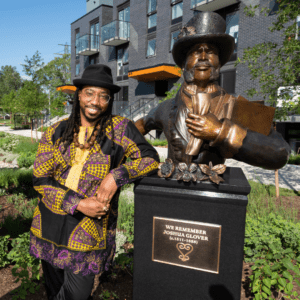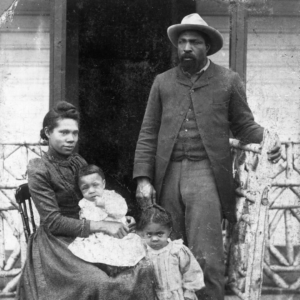As Canadians age, we believe it’s never too late to learn something new, or to reflect on the history we’ve lived through. Since February is Black History Month, it’s important to recognize the efforts of everyone who helped shape the Canada we live in now. This month, we’re celebrating a few individuals you may not know yet, and their achievements. Let’s learn their stories, and gain more appreciation for Canada’s past, and how to forge a better future.

A statue of Glover in Etobicoke, alongside the sculptor, Toronto artist Quentin VerCetty. Credit: VerCetty Made It Studios
Joshua Glover
One of many former slaves who escaped to Canada for freedom, Joshua’s story is unique because his journey became one of the catalysts for America’s abolitionist movement. Before settling in the area we now call Etobicoke, he was re-captured during his travels and imprisoned in Milwaukee, but was shortly after freed when a crowd of hundreds broke him from his cell. Upon arriving in Canada, he found employment, and solidarity, with Toronto’s community of Irish Protestants, and eventually became one of the first Black homeowners in the region.
Learn more: In Pursuit of Freedom: The Life of Joshua Glover (Heritage Toronto)

Viola Desmond
You may have seen her face on Canada’s vertical ten-dollar notes, but what is Viola’s story? As a business owner and educator in Halifax, she was a well-admired figure in the local Black community for providing career training to young women. In 1946, nine years before Rosa Parks’ bus protest in Alabama, Viola entered a cinema in Nova Scotia and refused to vacate the white-only seating area. Her arrest and prosecution exposed the shortcomings of Canada’s legal system and how the nation still had to contend with racial injustice. The walk to justice continues today, as Viola’s pardon wasn’t issued until decades after her passing.
Learn more: Viola Desmond’s Life & Story (The Canadian Encyclopedia)

John & Mildred Ware
For lovers of the Old West, this power couple are need-to-know historical figures. Ware became one of the first Black men to settle in Alberta, and his skill with horses and cattle soon became a local legend. Despite the racism he faced, he was already a respected cowboy by the time he married Mildred, who managed the bookkeeping and business affairs for their ranches, also teaching their family to read and write. Their life story was the subject of the 2020 documentary, John Ware Reclaimed.
Learn more: Watch John Ware Reclaimed for free (National Film Board)

The No.2 Construction Battalion
Throughout Black Canadian history, some chose to serve their country despite knowing the very same country would not treat them equally. One example is this Battalion from the First World War. Refused combat roles, these enlisted men aided in lumber production and the building of trench supports, walkways, and observation posts on the battlefield. This unit was later called “Canada’s best-kept military secret”, although sadly, part of the reason for this nickname was because most servicemen never received honours or recognition during their lifetime. In 2022, the Canadian government apologized to the unit’s descendants and told their story with a commemorative coin.
Learn more: Resilience and Determination to Serve: The Story of Canada’s No. 2 Construction Battalion (The Royal Canadian Mint)
Try these resources to keep learning:
-
Watch the National Film Board’s collection on Black Communities in Canada (note: this collection was curated for teens, but can be enjoyed by all ages)
-
Listen to the ‘Strong and Free’ Podcast



